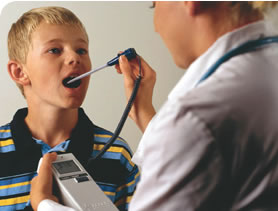Taking oral temperature is, when thermometer is used in your mouth for to check the temperature. Here are important guidelines and instructions for doctors when they are going to check the patient temperature.
- Explain the procedure to conscious patient for cooperation of the patient.
- Use an oral thermometer which has a pointed bulb end.
- The thermometer and cotton swab should be kept in a tray on top of bed side locker.
- Ask the patient if he has taken anything by mouth, if so wait for 10-20 minutes, otherwise the thermometer will not record actual body.This is very important step for taking oral temperature.
- Rinse the thermometer with plain cold water and wipe dry by cotton or gauze piece.
- Read the thermometer and shake down to 95°F or 35°C if i* reads more than this.
- Ask the patient to open his mouth. Place the thermometer under his tongue Instruct him not to bite or press hard the thermometer and close his lips gently.
- The thermometer should be kept for 1 to 2 minutes for correct recording.
- While taking the temperature and placing thermometer in position under tongue, the pulse and respiration can be counted to save time specially in hospital ward.
- If two thermometers are available the 2nd one can be placed with 2nd person and record temperature in the same way.
- After removal of thermometer and reading, bring down the column of mercury to 95°F or less.
- Clean the thermometer in plain water and wipe dry and kept in proper container.
- Record the temperature in chart or graph whatever is available.
- TPR are usually recorded in blue-black ink during day time and in red ink during night-time.
- When rectal or axillary temperature is taken it is mentioned in Graph as ‘R’ or ‘A’.
- Excess rise of temperature or excessive low temperature should be intimated to senior staff or attending physician.
Taking an oral temperature is a common and relatively easy method to measure someone’s body temperature. Here’s a simple guide in tabular format:
| Step | Description |
|---|---|
| 1. | Wash Your Hands – Ensure hygiene by washing your hands thoroughly with soap and water before handling the thermometer. |
| 2. | Prepare the Thermometer – If using a digital thermometer, ensure it is working and clean. If using a glass thermometer, shake it until the mercury falls below 96°F (35.6°C). |
| 3. | Clean the Thermometer – Clean the thermometer’s bulb with rubbing alcohol or soapy water, then rinse with cool water. |
| 4. | Place the Thermometer – Instruct the patient to open their mouth. Place the thermometer under the tongue to the side of the mouth. Instruct them to close their mouth and keep the thermometer in place with their lips, not their teeth. |
| 5. | Wait – For a digital thermometer, wait until it beeps. For a glass thermometer, wait 3-4 minutes. The patient should not talk or move during this period. |
| 6. | Remove and Read – Carefully remove the thermometer and read the temperature. |
| 7. | Clean Again – After each use, clean the thermometer using the same method as in Step 3. |
| 8. | Record the Temperature – Record the temperature and the time of day it was taken, especially if monitoring for fever. |
Remember, for accurate results, the patient should avoid eating, drinking, smoking, or exercising 15-30 minutes before taking an oral temperature.
Conclusion
In conclusion, language and linguistics are distinct yet interconnected concepts. While language serves as a vital tool of human communication, linguistics provides the scientific framework to study and understand language. Recognizing the difference between the two helps us appreciate the complexity of human expression and fosters a deeper understanding of the intricate workings of language.
